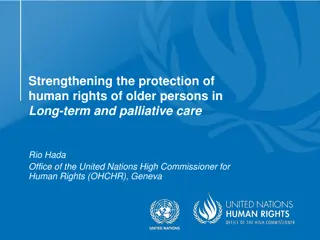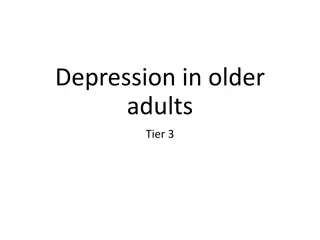Understanding and Respecting Older Adults: Challenges and Strategies
Exploring the misconceptions and challenges faced by older adults, this content highlights the importance of combating ageism in healthcare. It emphasizes the need for nurses to overcome stereotypes, involve older adults in decision-making, and address their unique needs with respect and understanding. The developmental tasks and interview techniques for interacting with older adults are also discussed, along with tips for assessing their needs effectively.
Download Presentation

Please find below an Image/Link to download the presentation.
The content on the website is provided AS IS for your information and personal use only. It may not be sold, licensed, or shared on other websites without obtaining consent from the author. Download presentation by click this link. If you encounter any issues during the download, it is possible that the publisher has removed the file from their server.
E N D
Presentation Transcript
How old is the older patient? Variability among older adults Physiological, cognitive, and psychosocial health Levels of functional ability Dependence vs. independence Strengths and abilities Terms Geriatrics Focuses on the diagnosis and treatment of diseases Gerontology The study of all aspects of the aging process and its consequences Gerontological Nursing Assessment of health & functional status of older adults. 2
Myths and Stereotypes Older adults are: Ill, disabled, and unattractive Forgetful, confused, rigid, boring, and unfriendly Unable to learn and understand new information Not interested in sex or sexual activities These ideas demonstrate ageism, which is discrimination against people because of increasing age.
Nurses Attitudes Toward Older Adults Nurses need to recognize and address ageism by questioning prevailing negative attitudes and stereotypes and reinforcing the realities of aging as they care for older adults in all care settings. It is critical for you to learn to respect older adults and actively involve them in care decisions and activities.
Developmental Tasks Box 14-2 Adjusting to decreasing health & physical strength Adjusting to retirement; limited income Adjusting to death of a spouse, friends Acceptance of aging Living environment or change in Redefining relationships Seeking quality of life Teaching: Box 14-1 5
Older Adult Interview Techniques Sit or stand at eye level, in front of the patient in full view. Face the older adult while speaking; do not cover your mouth. Speak clearly. Provide diffuse, bright, nonglare lighting. Encourage the older adult to use his or her familiar assistive devices such as glasses or magnifiers.
Assessing Older Pts Needs Focus on Older Adult Selection of a Care Facility Home Care Family involvement Environment Communication (sensory changes, hearing, vision) Staff Quality of life needs are best determined by a therapeutic nurse-client relationship that facilitates communication. 7
Physiological Changes Older clients concept of health revolves around how the perceive their ability to function. Not all physiological changes are pathological. Nurses need to be cognizant of normal age-related changes.
Physiological Changes (contd) General Survey Integumentary System Head and Neck Thorax and Lungs Gastrointestinal System and Abdomen Urinary System Heart and Vascular System Breasts Reproductive System Neurological System Musculoskeletal System
Functional Changes Functional status in older adults includes the day-to-day activities of daily living (ADLs) involving activities within physical, psychological, cognitive, and social domains. Changes are usually linked to illness or to disease and degree of chronicity. Performance of ADLs is a sensitive indicator of health or illness. Occupational and physical therapists are your best resources for a comprehensive assessment.
Cognitive Changes Delirium Acute confusional state Dementia Generalized impairment of intellectual functioning A mood disturbance characterized by feelings of sadness and despair Depression
Psychosocial Changes Retirement Social isolation Sexuality Housing and environment Death
Quick Quiz! 1. A nurse who has recently graduated has been assigned to be a primary nurse on a geriatric unit. After completing a review of development and aging, the nurse recalls that changes for the older adult include A. A transition from young adulthood. B. The ability of the older adult to achieve sexual arousal. C. A time when cognitive performance begins to peak. D. Adjusting to decreasing health and physical strength.
Healthy People 2020 Goals: Older Adults Increasing the number with one or more chronic conditions who report confidence in maintaining their conditions Reducing the number with moderate to severe functional limitations Reducing the number of emergency department visits resulting from falls
Healthy People 2020 Goals: Older Adults (cont d) Increasing the number who live at home but have unmet long-term services and support Increasing the number with reduced physical or cognitive function who engage in leisure-term physical activities
Health Promotion and Maintenance: Physiological Cancer Heart disease Stroke Smoking Alcohol abuse Nutrition Dental problems Exercise Falls Pain Sensory impairments Medication use
Health Promotion Preventive Measures Participation in screening activities Regular exercise Weight reduction, if overweight Eating a low-fat, well-balanced diet Moderate alcohol use Regular dental visits Smoking cessation Immunizations
Health Promotion and Maintenance: Psychosocial Concerns Therapeutic communication Touch Reality orientation Validation therapy Body image interventions Reminiscence
Older Adults and the Acute Care Setting Acute care settings pose risks for adverse events: Delirium Dehydration Malnutrition Health care associated infections Urinary incontinence Falls
Older Adults and Restorative Care Types of ongoing care: Continues recovery from acute illness Addresses chronic conditions that affect daily functioning Goal To regain or improve prior level of independence, ADLs, instrumental ADLs (IADLs)
Creative Commons License This work is licensed under a Creative Commons Attribution 4.0 International License. Except where otherwise noted, this content by Southern Regional Technical College is licensed under the Creative Commons Attribution 4.0 International License. To view a copy of this license, click https://creativecommons.org/licenses/by/4.0/ Healthcare Careers Work!(HCW) is sponsored by a $2.3 million grant from the U.S. Department of Labor, Employment & Training Administration. TAACCCT Grant #TC- 26488-14-60-A-13. Southern Regional Technical College is an equal opportunity employer and will make adaptive equipment available to persons with disabilities upon request. This workforce product was funded by a grant awarded by the U.S. Department of Labor s Employment and Training Administration. The product was created by the grantee and does not necessarily reflect the official position of the U.S. Department of Labor. The U.S. Department of Labor makes no guarantees, warranties, or assurances of any kind, express or implied, with respect to such information, including any information on linked sites and including, but not limited to, accuracy of the information or its completeness, timeliness, usefulness, adequacy, continued availability, or ownership.























